FSSAI Invites online applications for 9th FSSAI Food Analyst Exam 2023 and 6th Junior Food Analyst Examination 2023. Computer Based Test (CBT) will be conducted on 3rd September 2023 (Sunday) and the Practical Examination of 9th FAE will be on 2nd week of November 2023 onwards.
Job role of Food Analyst
Food analysts play a vital role in ensuring the safety and quality of food products. They work in laboratories to analyze food samples for a variety of contaminants, including bacteria, chemicals, and toxins. They also conduct research on food safety and quality, and develop new methods for testing food products.
- Conducting laboratory analysis of food samples
- Identifying and quantifying contaminants in food
- Developing new methods for food testing
- Writing reports on food analysis results
- Providing technical support to food manufacturers and retailers
- Complying with food safety regulations
Food Analyst Exam Dates
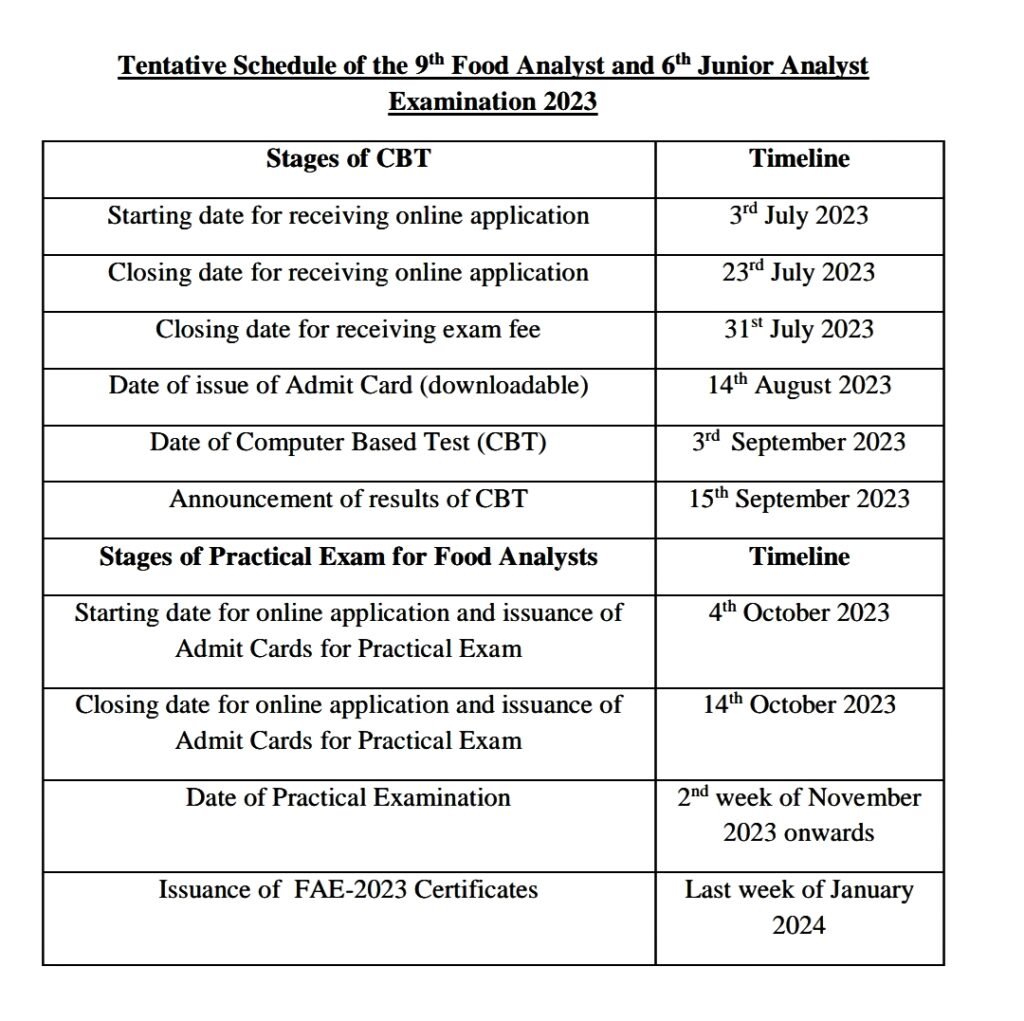
Eligibility Criteria for FSSAI Junior Food Analyst
- Essential Educational Qualification: The candidate should hold a Bachelor’s or Master’s or Doctorate degree in Chemistry or Biochemistry or microbiology or Dairy Chemistry or Agriculture Science or Animal Science or Fisheries Science or Biotechnology or Food safety or Food Technology, Food and Nutrition or Dairy Technology or Oil Technology or Veterinary Sciences from a university established in India by law or is an associate of the Institution of Chemists (India) by examination in the section of Food Analysts conducted by the Institution of Chemists (India) .
- Essential Experience: No experience is required.
- Reservation:-There is no reservation in whatsoever form since this is not for employment.
- There is no age limit for appearing in 6th JAE.
- Fee: – Rs.1500/- non-refundable through online mode along with the application.
👨💻 Prepare for Exams – Join Mock tests
🔖 Make your resume more stronger 🖥️ ISO22000 (HACCP and PRPs) for Food Safety Internal Auditor – GIFSTS
Eligibility Criteria for FSSAI Food Analyst
- The online applications are invited from candidates possessing essential educational qualifications and 3 years’ experience in terms of sub rule (ii) of Rule 2.1.4 of Food Safety and Standards Rules, 2011 under the Food Safety and Standards Act, 2006.
- Essential Educational Qualification: The candidate should hold a Bachelor’s or Master’s or Doctorate degree in Chemistry or Biochemistry or microbiology or Dairy Chemistry or Agriculture Science or Animal Science or Fisheries Science or Biotechnology or Food safety or Food Technology, Food and Nutrition or Dairy Technology or Oil Technology or Veterinary Sciences from a university established in India by law or is an associate of the Institution of Chemists (India) by examination in the section of Food Analysts conducted by the Institution of Chemists (India) .
- Essential Experience: The candidate should possess not less than three years’ experience in the analysis of food in any ISO: 17025 accredited food testing laboratory/research institutions/ research laboratory after attaining the minimum essential academic qualification specified above for 9th FAE
- The Junior Analyst after acquiring 3 years’ mandatory experience in analysis of food may appear only in Practical Examination as and when conducted in future. The opportunity for appearing in Practical examination for Junior Analysts after acquiring 3 years of experience will be provided only once. Upon qualifying Theory examination, the Junior Analyst will become eligible to be declared as Food Analysts under FSSR, 2011.This opportunity is available to qualified JAE only once in a life time.
- Age limit: – There is no age limit for appearing in the 9th FAE 2023.
- Reservation: -There is no reservation in whatsoever form since this is not for employment.
- Fee: – Rs.2000/- non-refundable through online mode along with application.
- The candidates who qualify Computer Based Test (CBT) as per the laid down criteria and fulfil the requirement as mentioned in the eligibly criteria will only be allowed to appear in Practical Examination.
- Dates of Practical examination will be intimated separately.
FSSAI Food Analyst Examination Details
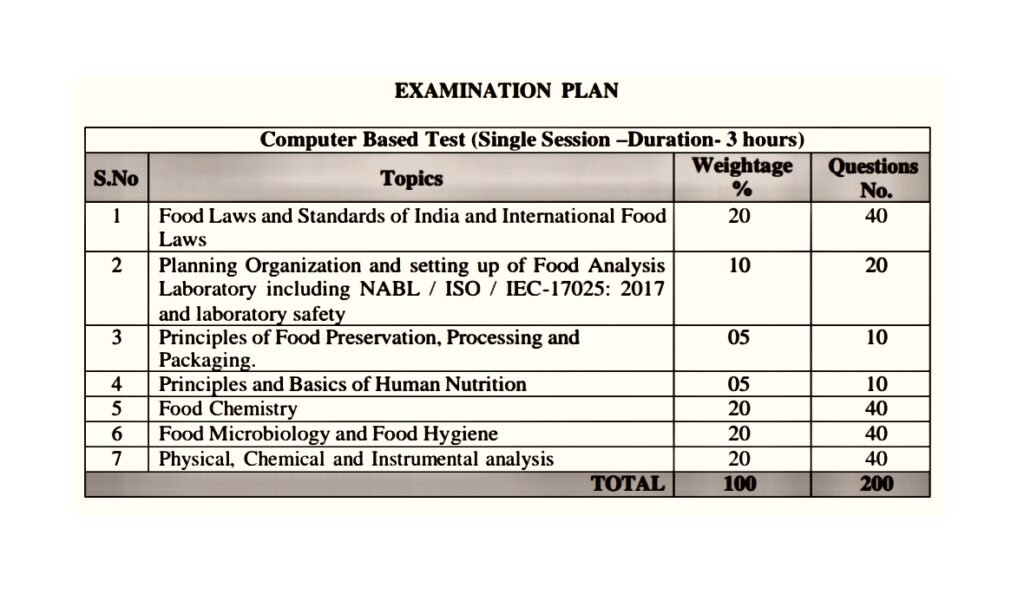
- All questions will be of Multiple Choice Questions (MCQ) type.
- Four marks will be awarded for each correct answer and one mark will be deducted for each incorrect answer.
- The FAE/JAE candidates should secure a minimum of 40% marks to qualify Computer Based Test (CBT).
- The candidates of FAE-2023 who qualify the Computer Based Test (CBT) will be eligible to appear for Practical Examination. Date, venue and syllabus of Practical Examination will be intimated separately.
- The candidates of JAE-2023 who qualify the Computer Based Test will be awarded certificate as qualified Junior Analyst. JAE qualified candidates will be allowed to appear for Practical Examination for FAE, only after obtaining the requisite experience of 3 years in analysis of food. This opportunity is available to qualified JAE only once in a lifetime.
- Syllabus for Computer Based Test is provided here.
🔖 Make your resume more stronger 🖥️ ISO22000 (HACCP and PRPs) for Food Safety Internal Auditor – GIFSTS
👨💻 Prepare for Exams – Join Mock tests
FSSAI Food Analyst Examination Syllabus
1) Food Laws and Standards of India and International Food Laws
I. Food Safety and Standards Act of India, 2006: Provision, definitions and different sections of the Act and implementation.
II. FSS Rules and Regulations (2011) as amended from time to time.
- Licensing and registration: Central license, State license, Registration, Responsibilities of the FBO, Role of Designated officer, Food Safety Officer and
Food Analyst. - Standards of Quality and Safety of Food & Food Products laid down in the FSS Regulations, 2011. The different food categories in the Act. The relevance of the standards (Vertical and Horizontal) quality and safety parameters to particular foods including current food safety issues.
- Regulations of food additive: What is an additive, various groups of additives and their technological functions, INS number: food colors, antioxidants, sweeteners, preservatives, processing aids. Food processing aids. The Indian Food Code and using thehierarchy to understand the category wise approval of Food additives.
- Packaging and labelling rules and regulations: List of ingredients, nutritional information, special label declarations, claims -Health, nutrition, nutrient led claims, use of words and phrases on label
- Regulations for Contaminants, Toxins and Residues and restriction of sales.
- Food Safety and Standards (Food or Health Supplements, Nutraceuticals, Foods for Special Dietary Uses, Foods for Special Medical Purpose, Functional Foods and Novel Food) Regulations, 2016Food Safety and Standards (Food Recall Procedure) Regulation,2017Food Safety and Standards (Import) Regulation, 2017
- Food Safety and Standards (Organic Food) Regulation, 2017. Food Safety and Standards (Fortification of Foods) Regulations, 2018 Food Safety and Standards (Alcoholic Beverages) Regulations, 2018
- Laboratory sampling and analysis: The role of Referral labs, FSSA notified laboratories and State Food Laboratories and functions. Receiving legal samples, sample custody and sample custodian. Storage of sample. Required documentation and registration, storage of the sample Analyses as per FSS Rules and Regulations (2011).
III. Other National Laws and Standards
- Agricultural Produce Act, 1937 (Grading and Marketing)
- Export (Quality Control & Inspection), Act, 1963 and Rules
- Bureau of Indian Standards relevant to Food Safety (Water, Infant Formula, etc)
- Legal Metrology Act
IV. International Food Control Systems/ Laws, Regulations and Standards/ Guidelines with regard to Food Safety:
- CODEX Alimentarius Commission: History, Members, Standard setting and Advisory mechanisms: JECFA, JEMRA, JMPR
- WTO agreements: SPS/TBT
- Role of OIE, IPPC.
2) Planning Organization and setting up of Food Analysis Laboratory including NABL / ISO / IEC-17025: 2017 and laboratory safety.
I. Understand the requirements for setting up a laboratory for the legal defensibility of analytical data. The ideal structure design, environment, layout for chemical and microbiological testing, Air handling, etc
II. What is accreditation, Different accreditation bodies (NABL, APLAC, ILAC). Requirements for ISO/IEC 17025:2017, documentation, pre-requisites for
accreditation, management requirements, technical requirements, measurement of traceability
III. Laboratory safety: Personnel and laboratory hygiene, emergency planning, General hazards in a food laboratory, safety equipment, storage of chemicals,
acids, flammables etc, handling compressed gases, centrifuge, chemical and biological spillsand waste disposal.
3) Principles of Food Preservation, Processing and Packaging.
I. Food Processing Operations: Manufacturing processes: batch, Semi-batch and continuous Cleaning of raw materials: cleaning methods and contaminations, Size reduction and screening of solids: equipment, modes of operation. Disintegration of materials: slicing, dicing, shredding, pulping. Mixing and emulsification. Filtration and membrane separation: principles, design features and general applications Centrifugation: principles and applications. Solid-liquid extraction and expression. Sorting and grading of foods: weight, size, shape, buoyancy, photometry sorting
🔖 Make your resume more stronger 🖥️ ISO22000 (HACCP and PRPs) for Food Safety Internal Auditor – GIFSTS
II. Food Preservation
- Heat: Principles of Heat Transfer, Blanching, Pasteurization, Heat Sterilization, thermal extrusion, cooking
- Water Removal: Forms of Water in Foods, Sorption of Water in Foods, WaterActivity, Drying and Evaporation Technology
- Temperature Reduction: Chilling, Freezing
- Radiation: Ionizing Radiation, Microwave
- By use chemicals: Class-I and Class-II preservatives, smoke other Chemical Additives
- New non-thermal methods: high hydrostatic pressure, modified atmosphere, high-intensity pulsed electric fields, intense pulsed light, oscillating magnetic fields), hurdle technology, ultrasonic and ohmic heating etc
III. Food Packaging:
- Effect of Environment on Food Stability: Light, Oxygen, Water, Temperature, Sensitivity to Mechanical Damage and attack by biological agents
- Different packaging material s used for food packaging and their properties –including barrier properties, strength properties, and optical properties: Glass, Metals, Paper, Plastics, Biodegradable and Edible Films and Coatings, aseptic packaging and Combinations.
- Selection of packaging material and design for various food commodities including fresh produce (fruits and vegetables), milk and milk products (dairy),
cereal, pulses, oil, meat, fish, poultry, water and processed foods. - Evaluation of quality and safety of packaging materials – different testing procedures
- Functions of Packaging: Protective Packaging and active packaging smart and intelligent packaging.
- Newer packaging technologies- CAP/MAP packaging, aseptic processing and packaging, irradiated packaging, retort pouch, microwaveable packaging
4) Principles and Basics of Human Nutrition
a) Water: sources, body’s needs, physiologic function
b) Body composition, Energy metabolism and nutritional requirements of the body. Recommended daily allowance (RDA), Basic metabolic rate (BMR)
c) Carbohydrates: Digestion of Simple and complex carbohydrates, dietary fiber, absorption of glucose, carbohydrate metabolism, Diabetes.
d) Lipids: Triglycerides, digestion, absorption, and transport, essential fatty acids (EFA), metabolism of fats. Cholesterol role in cardiovascular disease
e) Protein: Essential and nonessential amino acids, digestion and absorption of protein, protein metabolism, protein quality (biological value, protein efficiency ratio, net protein utilization intake and role in the body.
f) Vitamins: Deficiency diseases toxicity, sources, and function.
g) Minerals: Major and minor minerals nutritional significance and physiological role of dietary calcium, phosphorus, magnesium, iron, iodine, zinc and copper, selenium. (their dietary sources and deficiencies).
h) Macronutrient deficiency diseases, Overnutrition, Undernutrition, Malnutrition (Kwashiorkor & Marasmus)
i) Food allergens, Allergenicity and Inborn errors of metabolism
j) Diet and Health: Diabetes, cancer, stroke, hypertension, heart health
5) Food Chemistry
I. Water: Water as a nutrient, function, sources, requirement, structure, water balance – effect Moisture in food: Hydrogen bonding, cohesion and adhesion
properties, specific heat, osmosis colloidal properties of foods. Acid – base balance, pH, Hydrogen ion concentration, Buffers and Henderson Hasselbach
equation.
II. Carbohydrates: Nomenclature and different methods of classification, structure and chemical properties of monosaccharide, disaccharides and polysaccharides and complex carbohydrates; amino sugars, proteoglycans and glycoproteins. Reducing and non- reducing sugars, Optical and stereoisomerism.Different Color reactions of carbohydrate. Changes in carbohydrates during processing. Maillard reaction
III. Proteins and amino acids: Classification of amino acids based on structure; aromatic, aliphatic, acidic, basic, sulfur containing, branched chain, essential and non-essential amino acids. Globular& Fibrous protein, Hierarchy in structure (primary, secondary, tertiary), isoelectric point, Protein denaturation,
digestibility. Color reactions of proteins and amino acids. Amino acid analysis, protein digestibility corrected amino acid score (PDCAAS). Rheological
properties of protein- solubility, viscosity, gelling, surfactants/
IV) Lipids: Classification, nomenclature, structure, properties and functions of fatty acids,fats, phospholipids, sphingolipids, cerebrosides, steroids, cholesterol, plant sterols, bile acids, prostaglandins, lipoamino acids, lipoproteins, proteolipids, lipopolysaccharides. Reactions of lipids, oxidative and hydrolytic rancidity. Differenttypes of fats, uses in food processing, food emulsions, fat replaces, esterified fats. Changes during food processing. Protein lipid interaction, Lipid Carbohydrate interaction, Lipid-Lipid interaction. Fatty acid analysis and composition
V) Vitamins: Water- and fat-soluble vitamins: Classification, structure, physiology biochemical functions as coenzyme. Effect of various processing treatments and fortification of foods.
VI) Food Additives: Structure, Chemistry, Function and application of Preservatives, Emulsifying and Stabilizing agents, Sweeteners, buffering agents, bleaching, maturing agents and starch modifiers, Food colors, flavors, anti-caking agent, Antioxidants etc. The nature, properties and functions and mode of action. Safety assessment of Food additives: No-observed Effect Level (NOEL) Acceptable daily intake (ADI), Dietary exposure,) in chronic toxicity studies
VII) Antinutritional Factors: Protease Inhibitors, Haemagglutinins (Lectins), Glucosinolates, Cyanogens, Saponins, Gossypol, Lathyrogens, Antivitamins,
Antiminerals. Bitter substances, tannins and their removal from foods.
VIII) Food Enzymes: Properties, classification, enzyme units, enzyme kinetics, MichaelisMenten equation, regulatory enzymes, isoenzymes, enzyme inhibition and kinetics of enzyme inhibition, elements of bioenergetics. Role in foods: Beta – galactosidase, alpha galactosidase, proteases (papain, bromelain), lipases, oxidases etc,Polyphenol oxidase, enzymatic and non-enzymatic browning.
IX) Nucleic Acids: DNA: Physical and chemical properties (renaturation anddenaturation). Structure of nitrogenous bases, nucleosides, nucleotides, DNA
Doublehelix -Watson & Crick model of DNA,RNA Classes; mRNA, tRNA and rRNA.
X) Nutraceuticals and Functional Foods: Definition and function of Nutraceuticals, Functional Foods, Food Supplements, Dietary supplements prebiotics and
probiotics, Medical foods and foods for special purposes. examples Phenyl alanine free diet for Phenylketonuria patients, Lactose free for Lactose intolerant.
XI) Plant pigments: Structure and function of Chlorophylls, lycopene, betalaine, curcuminoids, annatto, Carotenoids, anthocyanins, flavonoids, melanin, tannins, quinones, and xanthone. And roles in food industry.
XII) Radioisotopes: Origin and properties of radioactivity. Detection and measurement of radioactivity, Geiger-Muller Counter, and types of scintillation counters and counting, Scintillation counting of γ ray, Concept of dpm and cpm. Applications of irradiation in food preservation/safety. Safety rules for handling radioactive materials
XIII) Genetically modified organism (GMOs): What are GMOs? Which are the major MOs in food and what are the traits that have been engineered. How to detect and quantify GMOs.
XIV) Food contaminant and adulterants: Major Classes of Pesticide and their residues. Heavy metals. Antibiotic & hormone residues, Veterinary drug residue, other new contaminants and toxins (For example: Cyclopiazonic acid in Buckwheat flour) , radioactive nuclides, mycotoxins (Aflatoxin, Ochratoxin, Patulin, DON, Ochratoxins, Sterigmatocystin, Fumonisins, Zearalenone). Common Adulterants: Lead chromate, mineral oil, urea, SDS, starch, blotting paper, metanil yellow, Rhodamineargemone, khesari dal, brick power etc,)
6) Food Microbiology& Food Hygiene
I. Introduction to Food microbiology: Classification and nomenclature of microorganisms. Morphology and Structure of Microorganisms in Foods (Yeasts
and Molds, Bacterial Cells Viruses). Important genera of Mold, yeast, bacteria (gram- negative aerobesandfacultative anaerobes, gram-positive cocci,
endospore-forming rods, non-sporulating), bacterial groups (lactic acid, acetic acid, butyric acid etc), thermophilic, proteolytic, saccharomyticetc, coliforms,faecal coliforms, enteric pathogens. Emerging microbes.
II. Sources of microorganisms in food chain (raw materials, water, air, equipment
etc) and microbiological quality of foods
III. Microbial Growth Characteristics: Reproduction and growth (fission, generation time
optimum growth, growth curve etc). Microbial growth in foods: Intrinsic (pH,
Moisture Content, Oxidation–Reduction Potential, Nutrient Content,
Antimicrobial Constituents) and Extrinsic Parameters (Temperature of Storage,
Relative Humidity of Environment, Presence and Concentration of Gases in the
Environment).
IV. Thermal Destruction of Microorganisms, Thermal Death Time, D Value , Z Value, F Value , Thermal Death Time Curve, 12 D Concept.
V. Microbial food spoilage and Food borne diseases, food pathogensAeromonashydrophila, Bacillus cereus and other Bacillus Species, Brucella, Campylobacter, Clostridium botulinum, Clostridium perfringens, Enterobactersakazakii, Escherichia coli, Listeria monocytogenes, Salmonella,
Shigella, Staphylococcus aureus, Vibrio, Yersinia enterocolitica, Fungi, virus etc
VI. Methods for the Microbiological Examination of Foods: Sampling Two-class and three-class sampling plan. Pure culture isolation: Streaking, serial dilution and plating methods; cultivation, maintenance and preservation/stocking of pure cultures; cultivation of anaerobic bacteria, and accessing non-culturable bacteria. Indicator Organisms: Direct Examination, Enumeration Methods, Plate Counts, Most Probable Number Counts, biochemical test, Rapid Methods for Detection of Specific Organisms and Toxins, Immunological Methods, DNA/RNA Methodology
VII. HACCP and Food Safety Management Systems: ISO 22000: Importance of implementing a HACCP system and how it can be applied to various products.
Prerequisite Programs, HACCP Principles, Some Limitations of HACCP Food Safety Objective (FSO). Food Safety Audits: management review, audit
certification and its importance. Good Manufacturing Practices (GMP) GoodHygienic Practices (GHP), Food Safety Plan, Food Safety Management Risk
Analysis. Traceability, food product recall. Sanitation
7) Physical, Chemical and Instrumental analysis
I. Sampling and sample preparation: Definition, types of sample, sampling plan, subsampling, designing a sampling plan, concept of sample size and representative. Sample preparations – particle size, homogeneity, dissolution technology anddecomposition, storage of samples.Solid Phase Extraction- Introduction, sorbents, matrix solid phase dispersion and applications.
II. Statistics and statistical terms: Systematic and random errors. Mean distribution. Confidence interval. Confidence limits and confidence level. Outliers. Definition and calculation of: Average, Mean, Standard deviation, Relative standard deviation, Coefficient of variation, Confidence limits of a measurement, Statistical Tests, Linear correlation and regression curve fitting, fitting of linear equations. Choosing and using statistical tests, Analysis of Variance (ANOVA),
III. Basic principles of Classical Methods of food analysis: Law of mass action, Lechateliers principle, stoichiometry, volumetric and gravimetric analysis. Preparation of standards, working standards and solutions of known concentration (percent, molar, molal, normal, ppm and ppb) and their dilution. Proximate analysis, physical methods for extraneous matter analysis
IV. Classical analytical techniques: Gravimetry, Titrimetry, Refractometry and Polarimetry : Principle, Instrumentation and applications of each technique in food analysis
V. UV-Visible and Fluorescence Spectrometry: Electromagnetic spectrum, Beer and Lambert’s Law, Absorbance, Transmittance, Molar absorptivity (Molar Extinction coefficient), E 1%, Max. Components and functioning of an UV-visspectrophotomer: Single beam and double beam. Components of a UV-VIS
spectrum. Calibration curve and applications in food analysis.
VI. Raman spectroscopy: Principle Theory Instrumentation, techniques and Applications of Raman spectroscopy in food analysis
VII. Chromatographic techniques: Fundamentals of chromatographic separations and their classification. The plate theory. Capacity factor and resolution factor. Chromatographic efficiency. Van Deemter’s equation. Partition coefficient etc. Principles and applications of paper (Ascending, Descending, Radial, Two dimensional) Partition, Thin layer chromatography, HPTLC, size exclusion and ion exchange chromatography. Applications in food analysis
VIII. High Performance Liquid Chromatography (HPLC): Basics of liquid chromatography, HPLC columns and Stationary phases (solid, liquid) – Bonded
phase supports, mobile phases, isocratic and gradient elution, Detectors: UV absorption, Fluorescence detector, RI detectors, electrochemical detectors, Photo diode array, Evaporative light scattering detector, PHRED anatomy of a chromatograms. Modes of separation Normal and Reverse Phase. Sample
Preparation Techniques, Applications in quantitative food analysis of aflatoxins, vitamins, sugars, sweeteners, preservatives etc.
IX. Gas chromatography: Basics of Gas chromatography, Mobile phase and criteria for its selection – Sample introduction techniques – Stationaryphases– Supports for liquid stationary phases, Selection ofcolumns. Detectors FID, TCD, FPB, ECD, TID. Temperature programming in GC – Derivatizationand sample preparation in GC – Fatty acid profile and quantitative analysis of fatty acids in fats and oils.
X. Mass Spectrometry: Basics of mass spectrometry, Components of a mass spectrometer, Ionization and ion sources: Electrospray, chemical, Fast Atom
Bombardment, MALDI, Atmospheric Pressure Chemical ionization and other ionization methods. Mass analyzers: Quadrupole Analyzers, Ion Trap Analyzers, Electrostatic Trap or ‘Orbitrap’, Time-of- Flight Analyzers, Hybrid Instruments. Detectors: Photographic plate, Faraday cup Electron multipliers. Data acquisition, Data conversion, Data reduction andLibrary search. Tandem Mass Spectrometry and its applications.
XI. Hyphenated Techniques: Mass Spectrometry and Chromatography Coupling. GC-MS/MS, LC-MS/MS, Capillary electrophoresis-MS, Isotopic Ratio mass
spectrometry. Analytical Information: Mass Spectrometry Spectral Collections, high resolution, quantitative data, fragmentation and spectrum interpretation.
XII. Atomic absorption Spectroscopy, Atomic emission spectroscopy, ICP-MS: Principles-Atomization process, Atomic line widths and radiation sources for AAS, temperature gradients, cells detectors, interferences, Background correction methods and modifications in instrumentations, Atomic EmissionSpectroscopy: Atomic spectra, Population distribution with temperature, Sources, spark laser microprobe for atomic emission, Spectrometers, Merits, demerits, and applications. Basic principles and instrumentation of ICP-MS; data acquisition and interpretation; applications of ICP-MS for analysis of metallic contaminants in food. Sample preparation, microwave digestion.
XIII. Biological Techniques (DNA/protein based): Fundamental principles and instrumentation of the systems; measurement techniques and result interpretations of Polymerase Chain Reaction (PCR), Real-time Polymerase Chain Reaction (PCR) technique; Enzyme Linked Immunosorbent Assay (ELISA); Radioimmunoassay (RIA). Use of PCR for detection of genetically-modified organisms (GMO);meat and fish speciation and other applications in analysis of food adulteration.
XIV. Measurements of Rheological properties: Instrumental Measurement of Texture of Foods, Visco Analysis, viscometer, texture analyser etc.
XV. Quality assurance and Quality control: Introduction to quality control in analytical chemistry. Terminology in analytical measurements: True value, Measured value, Accuracy, Precision, Uncertainty, Random errors. Sample traceability, Internal quality control, Certified reference materials. Spiked reference samples. Recovery studies, Method validation/verification (LOD, LOQ, specificity, selectivity, linearity, range, robustness, repeatability, reproducibility. External and internal standards, Control chart. Proficiency testing, z scores.
📝 Prepare for exams – Join Mock test
General Instructions
- Candidate can apply either for 9th Food Analysts Examination (FAE), 2023 or for 6th Junior Analyst Examination (JAE), 2023
- Applications are to be submitted through the specified link only. Applications submitted through any other mode will not be considered.
- Candidates are requested to submit all the relevant documents with due care as submission of documents at the time of application will be considered as final.
- Acceptance of the applications is subject to verification of supporting documents submitted by the candidates.
- Any further revisions or any requests with respect to resubmission of documents will not be entertained.
- No relaxation in the Educational Qualification and/or experience is permissible. The candidates should ensure that the spelling of the name entered in the registration form is correct and the order of the first, middle and last name is mentioned correctly. No request for change in name or spelling of the name will be entertained after issuance of certificate.
- The name of the candidate mentioned in academic or experience documents (as uploaded with the application form) should be same as mentioned in registration form. In case of any difference in the name, sufficient supporting documents (eg: Marriage certificate) should be uploaded during the time of application, otherwise the candidature shall be cancelled.
- Candidates should upload the scan copy of original degree certificate or Provisional Degree Certificate (mark sheets will not be accepted). as the proof of eligible academic qualification. If documents with respect to educational qualification and experience in case of FAE are found to be illegible or inadequate, the application will be rejected.
- All educational qualifications must have been obtained from recognized universities / Institutions in India or abroad.
- Choice of examination centre is available in the online form. However, examination centres may be changed subject to the availability of the candidates for the respective examination centre.
- Registration Fee will be applicable for all candidates.
- The Examination Fee for CBT will be paid by those candidates whose applications have been accepted.
- Both Registration Fee and Examination Fee are non-refundable
- In case, fee is paid for one application more than once, the excess fee will be refunded
- Fee has to be submitted through the dedicated payment gateway only which would be available to the candidates during/after the submission of the applications. Fee submitted through any other mode will not be accepted.
- Mere submission of application / fulfilment of eligibility conditions will not confer any right on the candidate to be shortlisted / called for written test/ interview/issuance of certificate/job
Specific Instructions for the candidates appearing for the 6th Junior Analyst Examination 2023
Candidate applying for JAE should fulfil the eligibility criteria of Junior Analyst as given below:
- Educational Qualification will be the same as that of the Food Analyst as on closingdate of the application, as prescribed in Advertisement published for 6th JAE, 2023 i.e 23rd July 2023
- Experience: No experience required
Specific Instructions for the candidates appearing for the 9th Food Analyst Examination 2023:
- Candidate applying for Food Analyst should fulfil the eligibility criteria of Food Analyst as prescribed in the notification issued by FSSAI for 9th FAE 2023.
- Candidates appearing for 9th FAE 2023 should have minimum three years’ experience in analysis of food in any ISO:17025accredited food testing laboratory/research institutions/ research laboratory
- Experience certificate should be submitted in the prescribed format only.
- Experience of the candidate will be calculated from the date of graduation or the minimum eligible academic qualification as achieved by the candidate, till the closing date of application for 9th Food Analysts Examination (FAE), 2023 i.e 23rd July 2023
- The experience gained by the candidates before qualifying the minimum academic qualification as prescribed for the FAE and after the closing date of application will not be taken into consideration.
- Experience gained by the candidate during academic programmes such as Post Graduate, Doctoral Programme/SRF/JRF, etc will not be considered.
- Pre-qualified Junior Analyst after gaining requisite experience (3 years of experience in food analysis) can appear directly for the Practical Examination for one time.
Note
The candidates who have passed ISt or 2nd or 3rd or 4t’ or 50′ Junior Analyst Examination and have now acquired three years of experience in analysis of food and further fulfill the eligibility criteria as per Rule 2.1.4 of FSS Rules, 2011 are not required to apply through this online application. A separate notice as well as application form will be uploaded on the website of FSSAI in ISt week of July, 2023.
Contact
For any queries or clarification candidate may write to faexam.qa@fssai.gov.in
Prepare for your Exam.
🔊 Be Aware, We never charge any consultancy fee for jobs.
📲 Foodtech Network WhatsApp Jobs Group
🔗 WhatsApp Groups
🖥 Food Safety Training programs
🔗 https://bit.ly/3fbjKRz
📈 Food Entrepreneurs & Startups (Our services)
🔗 https://bit.ly/3JDyPIN
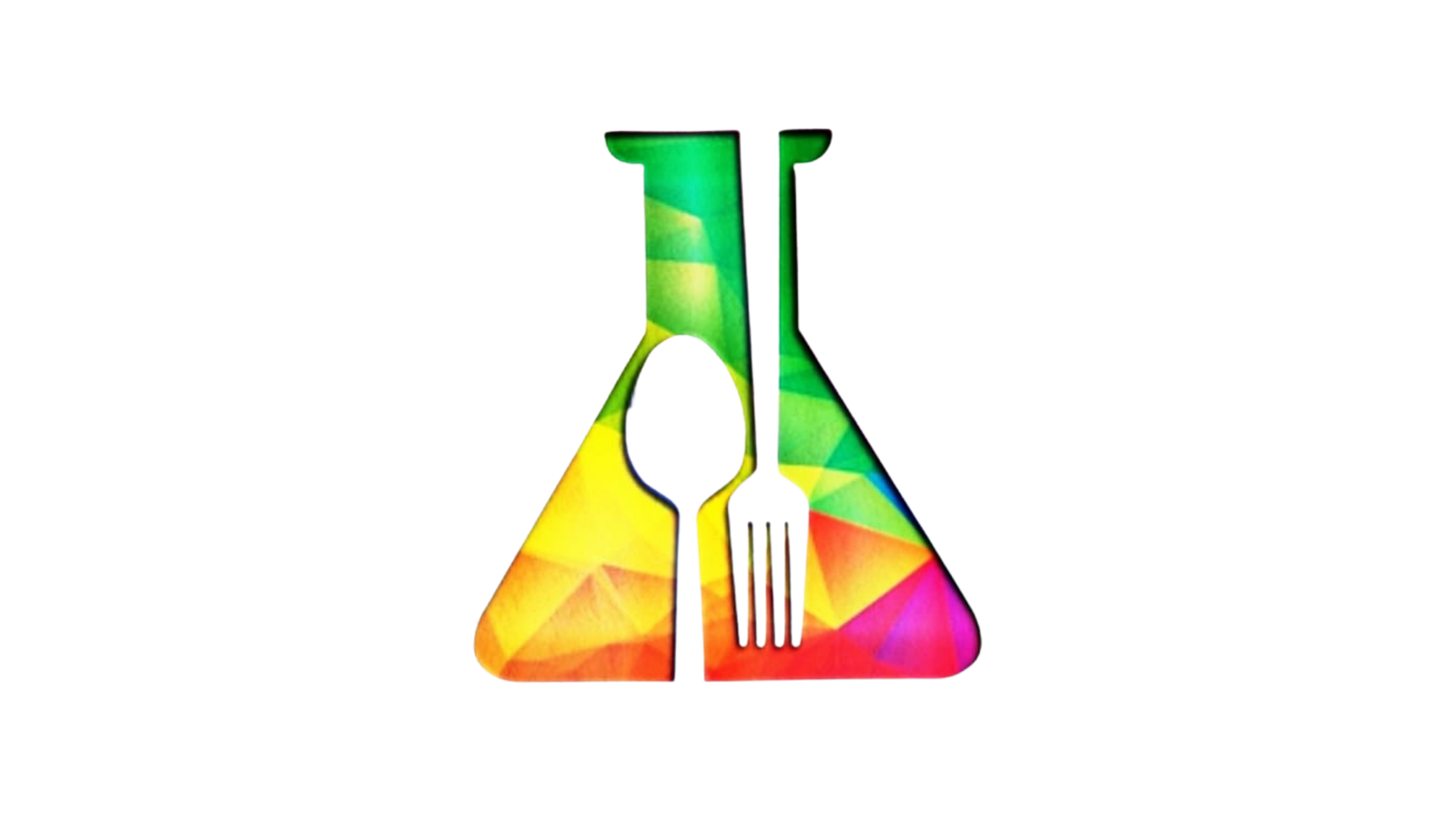


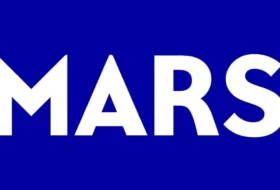

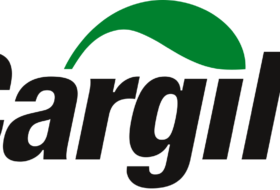



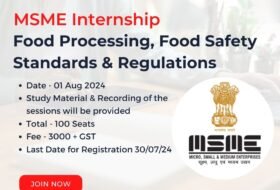
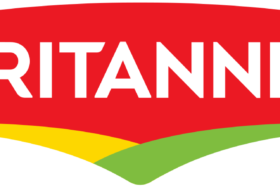


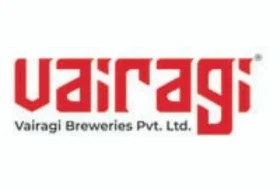




Comments